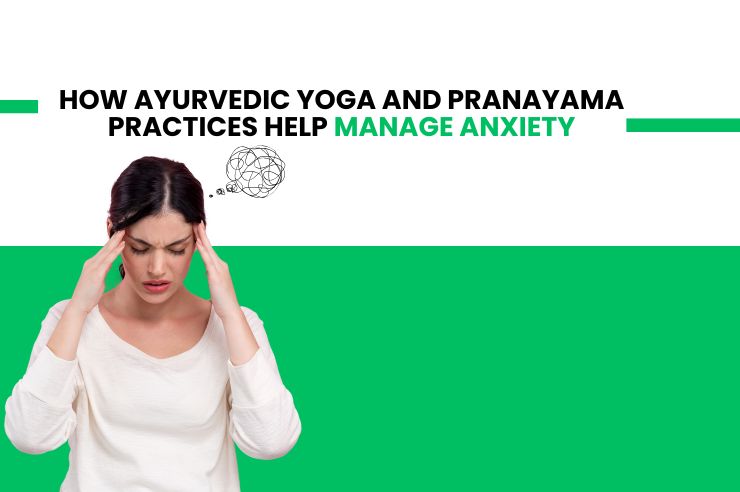Anxiety doesn’t always come crashing in like a storm. Sometimes, it tiptoes in quietly. It sits beside you during conversations, it hums under your breath when you’re lying in bed at night, and it walks with you through ordinary moments—when you’re making tea, commuting to work, or scrolling your phone. It’s the feeling of being slightly off—never fully here, never quite at ease.
If this sounds familiar, you’re not alone. Anxiety is the silent weight that so many people carry without knowing how to put it down.
While modern solutions often point toward temporary fixes or symptom suppression, the ancient sciences of Ayurveda, Yoga, and Pranayama offer something different: an invitation to go deeper. To understand why anxiety arises, and how to gently, consistently bring the body and mind back into balance.
This isn’t just theory. It’s a lived, felt practice. And it may just change your relationship with yourself forever.
The Ayurvedic Understanding of Anxiety: Not Just in Your Mind
In Ayurveda, anxiety isn’t labeled as a disorder. It is seen as a state of imbalance, particularly of Vata dosha—the energy associated with air and space.
Vata governs movement in the body: breath, thoughts, circulation, elimination. When Vata is balanced, we feel light, creative, and inspired. But when it becomes aggravated—due to poor sleep, overstimulation, irregular meals, excess travel, or too much time online—it leads to restlessness, fear, forgetfulness, and physical depletion.
What we call “anxiety” today is, in many ways, the modern expression of Vata gone rogue.
The beauty of the Ayurvedic approach is that it doesn’t pathologize your experience. It simply says: you are out of rhythm. And rhythm can be restored.
The Foundations of Ayurvedic Treatment for Anxiety
Ayurvedic treatment for anxiety works on multiple levels—physical, emotional, mental, and energetic. It doesn’t just seek to reduce anxiety but to heal the underlying cause.
Here’s how that process begins.
- Nourishment Over Stimulation
When anxiety is high, the body doesn’t need cleansing or restriction—it needs grounding nourishment. That means:
- Warm, well-cooked meals
- Foods with natural oils, like ghee or sesame
- Simple spices like cumin, ginger, fennel, and turmeric
- Avoiding cold, dry, or raw foods that aggravate Vata
Herbs also play a supportive role. Ayurvedic herbs like Ashwagandha, Brahmi, and Jatamansi calm the nervous system without dulling it. They strengthen the mind’s resilience, improve sleep quality, and ease nervous tension.
- Routine Brings Safety
Vata thrives on irregularity. So one of the most powerful tools for healing anxiety is the creation of daily rhythm—what Ayurveda calls Dinacharya.
This includes:
- Waking and sleeping at the same time every day
- Eating meals at regular intervals
- Starting the day with self-massage (Abhyanga) using warm sesame oil
- Ending the day with a wind-down ritual—no screens, just stillness
These small, repetitive actions signal to the body: You are safe. You are not in crisis. You can let go.
- Deep Reset with Ayurvedic Panchakarma Treatment
For those living with chronic anxiety, a deeper cleanse may be needed. Ayurvedic Panchakarma treatment is Ayurveda’s most profound form of physical and emotional detoxification. It’s not just a treatment; it’s a retreat back into your body. It removes deep-seated toxins (ama), balances doshas, and rebuilds inner strength.
Treatments like Shirodhara, where a stream of warm oil is poured gently on the forehead, are especially effective in calming the overactive nervous system. Clients often describe it as the first time in years they felt truly relaxed—without effort, without fear.
The Role of Yoga in Healing Anxiety
Yoga is more than a physical practice. In the Ayurvedic tradition, it is the movement medicine for the mind. When practiced mindfully, yoga helps restore Vata balance and regulate the nervous system.
Not all yoga is equal in this process. Fast, high-intensity classes can worsen anxiety. The focus here should be on:
- Gentle, grounding asanas
- Long, slow breathing
- Stillness between movements
Postures that support anxiety relief include:
- Balasana (Child’s Pose) – for emotional grounding
- Paschimottanasana (Seated Forward Bend) – for inward focus
- Viparita Karani (Legs-Up-the-Wall Pose) – to reverse stress
- Marjaryasana/Bitilasana (Cat-Cow) – to connect movement with breath
Even 15–20 minutes of a slow sequence can guide the body back into a parasympathetic state—the nervous system’s natural mode for rest and restoration.
Pranayama: The Breath That Knows the Way Back
If there is one tool that Ayurveda and yoga both rely on to treat anxiety, it is Pranayama—the conscious regulation of breath.
Most people in an anxious state breathe shallow, fast, and irregularly. The body responds as if it’s in danger, even when it’s not. Pranayama breaks this cycle. It restores breath to its natural rhythm, which in turn calms the mind.
The most effective techniques include:
Nadi Shodhana (Alternate Nostril Breathing)
Balances the left and right hemispheres of the brain. Ideal before sleep or during panic.
Bhramari (Bee Breath)
Uses soft humming to stimulate the vagus nerve and create internal calm. Gentle, but powerful.
Sheetali (Cooling Breath)
Draws heat out of the system—perfect for anxiety with anger or restlessness.
A daily Pranayama practice—just 5 to 10 minutes—can change the way you move through your entire day.
Final Reflections: This Is Not Just a Practice—It’s a Return
Anxiety makes us feel like we’re alone in a storm we can’t control. But Ayurvedic treatment for stress reminds us of something far more empowering: that healing doesn’t come from doing more—it comes from returning to what we’ve always known.
Returning to the breath.
Returning to rhythm.
Returning to the body.
Returning to stillness.
You are not broken. You are not weak. You are simply being called back into alignment—with your true nature, with the earth beneath your feet, and with the breath that has never left you.
In Ayurveda, this is not just treatment.
It is a homecoming.
